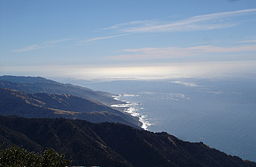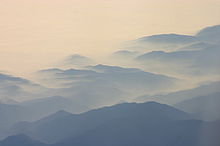- California Coast Ranges
-
For the entire range of the Pacific Rim, see Pacific Coast Ranges.
California Coast Range Range Santa Lucia RangeCountry United States State California Part of Pacific Coast Ranges The Coast Ranges of California constitute one of the eleven traditional geomorphic provinces of California. They include several but not all mountain ranges along the California coast (the Transverse Ranges, Peninsular Ranges and the Klamath Mountains are not included[citation needed]). Physiographically, they are a section of the larger Pacific Border province, which in turn are part of the larger Pacific Mountain System physiographic division. UNESCO has included the "California Coast Ranges Biosphere Reserve" in its Man and the Biosphere Programme of World Network of Biosphere Reserves since 1983.
Contents
Physiography
The northern end of the California Coast Ranges overlap the southern end of the Klamath Mountains for approximately 80 miles on the west. They extend southward for more than 600 miles to where the coastline turns eastward along the Santa Barbara Channel, around the area of Point Conception. Here the southern end meets the Los Angeles (Transverse) Ranges, or (Sierras de los Angeles).[1] The rocks themselves that comprise the mountains are of a great variety and widely varying geologic ages. Most of the rocks were formed during the Tertiary, Cretaceous and Jurassic periods. Most were deposited on the sea bottom as sediments, but in many places also had the cracks, crevices and other gaps infused with molten lava or other masses of igneous rock, which were forced in molten condition into the sedimentary rocks. All of the range has been folded and faulted during several periods, with erosion of the softer rock giving much of the current appearance.
Mineralogy
The California Ranges had a high production of mercury following the discovery of gold in the Sierra Nevada. In the Cache Creek Basin, cenozoic cinnabar deposits near Clear Lake are the northernmost of a group of similar deposits associated with volcanism and migration of a transform fault system. During 1877, these deposits hit their peak production of mercury, producing approximately 2,776 metric tons. These abandoned mines are still a source of mine waste runoff in Cache Creek and other downstream bodies of water.[2]
North Coast Ranges
The North Coast Ranges are a section of the Pacific Coast Ranges of western North America, which run parallel to the Pacific Coast from north of San Francisco Bay to the South Fork Mountains of northern Humboldt County. The Klamath-Siskiyou ranges lie to the north, and the Southern Coast Ranges continue south of San Francisco Bay.
 The North Coast Ranges meet the sea at the Lost Coast.
The North Coast Ranges meet the sea at the Lost Coast.
The North Coast Ranges run north-south parallel to the coast, and include the King Range of Humboldt County, where the coastal mountains meet the sea dramatically on what is called California's Lost Coast. Component ranges within the North Coast Ranges include the Mendocino Range of western Mendocino County and the Mayacamas, Sonoma, and Vaca Mountains and the Marin Hills of the North Bay. The North Coast Ranges consist of two main parallel belts of mountains, one lying along the coast, the other running further inland. They are separated by a long valley, the northern portion of which is drained by the Eel River and its tributaries, and the southern by the Russian River. A series of short rivers, including the Mattole, Gualala, and Navarro rivers, drain the western slopes of the range. The eastern slope of the North Coast Ranges drains into the California Central Valley. Clear Lake lies in the southeast portion of the range, and drains eastward via Cache Creek. The rivers of the north coast ranges are home to several species of salmon.
The seaward face of the coastal mountains is part of the Northern California coastal forests ecoregion, home to lush forests of Coast Redwood (Sequoia sempervirens) and Coast Douglas-fir (Pseudotsuga menziesii ssp. menziesii).
The drier inland portion is part of the California chaparral and woodlands ecoregion, and is home to a number of plant communities, including mixed evergreen forest, oak woodland, and chaparral. A major specific plant community of the inner ranges is Mediterranean California Lower Montane Black Oak-Conifer Forest, which supports particularly high biodiversity within the Coast Ranges.[3] California Mule Deer are the most widespread large mammal, after humans, of the Coast Ranges.
U.S. Route 101 runs north and south through the North Coast Ranges, following the valley of the Russian and Eel rivers. The southernmost peak of the North Coast Ranges is Mount Tamalpais.
South Coast Ranges
The South Coast Ranges are a group of mountain ranges, in the Pacific Coast Ranges, in central California. The South Coast Ranges run north and south, parallel to the Pacific Coast, between San Francisco Bay to the north, the California Central Valley to the east, the Transverse Ranges to the south, and the Pacific Ocean to the west. The South Coast Ranges include the Berkeley Hills, Mount Diablo, the Santa Cruz Mountains and Diablo Range of the San Francisco Bay Area, and the Gabilan Range, Santa Lucia Range, and Temblor Range of the Central Coast. ranges, including the Salinas Valley and the Carrizo Plain.
The South Coast Ranges have a Mediterranean climate, and are mostly within the California chaparral and woodlands ecoregion, although the western slope of the Santa Cruz Mountains lies within the Northern California coastal forests ecoregion. The Northern California coastal forests are characterized by forests of Coast Redwood (Sequoia sempervirens). Enclaves of redwood forest also occur in the Santa Lucia Range. The California chaparral and woodlands ecoregion has a great range of plant communities, including mixed evergreen forests, oak woodlands and savannas, grasslands, northern coastal scrublands, and the Monterey Pine (Pinus radiata) woodlands of the Monterey Peninsula and two other coastal enclaves. The highest point of the South Coast Ranges is Junipero Serra Peak, at 5,857 feet (1,785 meters), however there are many peaks in the North Coast Ranges that are significantly higher.
Some of the rarest forests that occurs in this coastal region are the Maritime Coast Range Ponderosa Pine forests, an example of which occurs in the Carbonera Creek watershed of Santa Cruz County, California.[4]
Ranges
Index links
- Category: California Coast Ranges
- Category: Mountain ranges of the San Francisco Bay Area
See also
- Geography of California
- Inner Coast Ranges
- North American Cordillera
References
- ^ J.S. Diller (1915) Guidebook of the Western United States: Part D. The Shasta Route and Coastline, U.S. Geological Survey, Bulletin 614, 7pp.
- ^ Domagalski, Joseph L.; Alpers, Charles N., Slotten, Darell G., Suchanek, Thomas H., and Ayers, Shaun M. (2004). Mercury and methylmercury concentrations and loads in the Cache Creek Basin, California, January 2000 - May 2001. U.S. Geological Survey, Scientific Investigations Report 2004-5037. p. 3. ISBN 1428984305.
- ^ C. Michael Hogan (2008) "California Black Oak (Quercus kelloggii)" Globaltwitcher.com, ed. N. Stromberg
- ^ Earth Metrics Inc. (1990) Environmental Impact Report for the Scotts Valley Redevelopment Area, State of California Clearinghouse Report 7888, Sacramento, California
External links
Categories:- California Coast Ranges
- Pacific Coast Ranges
- Mountain ranges of Northern California
- Geologic provinces of California
- Physiographic sections
- Mountain ranges of the Western United States
- Biosphere reserves of the United States
Wikimedia Foundation. 2010.


